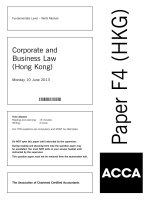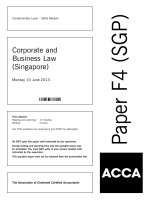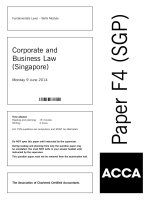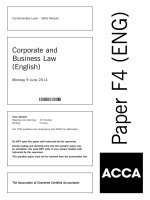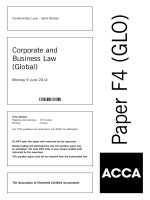Acca f4 corporate and business law russia 2013 jun answer
Bạn đang xem bản rút gọn của tài liệu. Xem và tải ngay bản đầy đủ của tài liệu tại đây (57.47 KB, 10 trang )
Answers
Fundamentals Level – Skills Module, Paper F4 (RUS)
Corporate and Business Law (Russia)
1
June 2013 Answers
The question tested the candidates’ knowledge of the role and structure of the courts of general jurisdiction, and the role of judges.
(a)
The courts of general jurisdiction deal with the majority of legal cases in the Russian Federation. Their scope of authority is
determined by a principle of exclusion, in that any cases that do not fall within the precise jurisdiction of the courts of
arbitration, the constitutional courts and other courts are dealt with by the courts of general jurisdiction.
The courts of general jurisdiction deal with criminal cases, civil cases and administrative cases. Cases that are dealt with by
the courts of jurisdiction include, inter alia:
(i)
Cases concerning civil disputes, family and labour relations, where at least one party is an individual.
(ii)
Disputes concerning public legal relations, where the power of one party is subordinate to another, and where an
individual is the subordinated party.
(iii) Challenges by individuals to normative legal acts if the contentious issue does not fall within the jurisdiction of the
constitutional courts.
(iv) Challenges to decisions concerning mass media, including refusals to issue licences, revocation of licences or
suspending the activities of mass media.
(v)
Disputes relating to public or religious organisations with public officials, and disputes between such organisations.
(vi) Other cases, including administrative legal relations, transportation agreements and cases in which one party is a foreign
citizen.
The courts are structured in a hierarchical manner, as set out in Articles 118 to 129 of the Constitution of the Russian
Federation.
The city and municipal courts operate at district level and are positioned at the lowest level of the hierarchy. They hear routine
cases, serving as courts of first instance.
The supreme courts of the republics of the Russian Federation, the regional courts, the city courts of Moscow and
St Petersburg and courts of autonomous districts and regions form the next level in the hierarchy. They deal with more serious
penal cases that lie beyond the jurisdiction of the city and municipal courts. These courts deal with appeals against the
decisions of the city and municipal courts. Decisions may be appealed on points of fact or points of law, subject to time limits.
The Supreme Court of the Russian Federation is the highest court. It serves as a court of first instance for very complex penal
and civil cases. It is also the court of final appeal on decisions of lower courts.
(b)
Judges preside over cases put before the courts. They have four broad roles to perform.
First, judges must ensure that proper process is followed for each case. This ensures that every hearing is conducted in a
consistent manner.
Second, judges must interpret the relevant laws applicable to each case. As the Russian Federation has a codified legal
system, the main sources of law are the Constitution, legal codes, federal laws and other subordinate laws. Many written laws
provide guidance on interpretation by explaining exactly what words and phrases contained in the legislation actually mean.
However, if the language used is ambiguous, or if words can be assumed to have additional meanings, it is up to the judge
to interpret them in the manner appropriate to each individual case.
Third, judges must resolve situations in which there is no written law upon which a decision can be made. In such instances,
a law lacuna arises. No matter how comprehensively a law is drafted, it is inevitable that future cases present problems that
were not originally anticipated by legislators. In order to resolve a law lacuna, the judge may resort to analogy with similar
laws, or may consider the general meaning of the law in order to come up with the most equitable outcome, consistent with
the perceived intention of the legislator. Ultimately, the law lacuna may be addressed by the enactment of new legislation, or
the amendment of existing laws. This responsibility falls to legislators and not to the courts, who are not empowered to create
laws.
Fourth, having heard each case, judges must take decisions. Depending on the level and jurisdiction of the court, decisions
may be taken by a single judge sitting alone or by a panel of judges. For certain types of case, a jury is convened to arrive
at a decision on the case and present its findings to the court once all evidence has been presented.
2
The question asked candidates to explain the provisions of the Civil Code in respect of offer and acceptance.
The law relating to offer and acceptance is set down in chapter 28 of the Civil Code.
Article 432(2) states that a contract is concluded when an offer has been forwarded and has been accepted.
An offer is a proposal by an offeror to one or more specific persons, that is sufficiently comprehensive and conveys the intention
of the offeror to regard himself as having concluded a contract if that offer is accepted. ‘Sufficiently comprehensive’ implies that
the offer shall include all the essential terms of the contract. The offeror is committed once the offer has reached the counterparty.
However, if the offer is withdrawn before or at the same time as the offer is received by the offeree, it is regarded as cancelled
(Articles 435 and 439).
7
Not all representations made by one party to another may be regarded as offers. Article 437 confirms that general invitations to
an indefinite number of persons, such as advertisements, are invitations to make an offer and, as such, are incapable of forming
a contract if accepted. The Article refers to ‘advertisements and other proposals’, so such representations would include goods on
display, general product information in newspapers and magazines, and so on. However, the same Article introduces the concept
of the ‘public offer’, which is any proposal containing the essential terms of the contract and clearly expressing the will of the issuer
to be bound by it.
An offer that includes a fixed term for acceptance cannot be revoked unless this is stated in the offer, or is clear from the context
in which the offer is made (Article 436).
Article 438 defines acceptance as the response by the person to whom the offer has been addressed assenting unconditionally to
all of the terms in the offer. This implies that partial acceptance is not possible, so any response with material modifications must
be regarded as a counter-offer. The practical effect of this is that a new offer is created which the original offeror may accept or
reject (Article 443).
Silence or inaction cannot generally be taken as acceptance, though Article 438(2) qualifies this by stating that silence may
constitute acceptance if it is consistent with previous business relations between the parties, or with customary business turnover.
The positive response of the offeree may be a concrete expression of willingness to be bound by the offer, or a positive action
consistent with acceptance, such as the despatch of goods, provision of services or payment of money (Article 438(3)).
Articles 440 to 443 lay down various provisions in relation to time limits. Acceptance is valid if it is communicated within the time
specified in the offer. If there is no time limit specified in the offer, the acceptance must be made within the time specified in any
laws relevant to the transaction, or otherwise within the normally required time. For offers made orally, acceptance is valid if the
counterparty immediately declares acceptance. Acceptance with delay may be valid provided the offeror does not declare otherwise.
3
The question asked candidates to explain the meaning of redundancy and the rights of employees who are made redundant.
(a)
Redundancy refers to any situation in which an employee is dismissed due to changes in the labour requirements of the
organisation, downsizing of the workforce or cessation of the enterprise.
Changes in the labour requirements of the organisation may be brought about by modification of processes (particularly those
driven by technology), changes in products or rationalisation of products offered to customers. For example, those engaged
in batch inputting of data will no longer be required if the organisation changes its system to operate on a real time, online
basis. Likewise, if a company withdraws a product, or makes substantial changes to how it is produced, certain employees
may no longer be required.
Redundancy also occurs if the enterprise closes a factory, office or branch, relocates or ceases production altogether. In the
event of total closure, all employees may be regarded as redundant de facto.
The Labour Code does not use ‘redundancy’ as a specific term, but alludes to situations in which employees may be dismissed
for the above reasons. Article 81 of the Labour Code states that a labour agreement may be terminated by an employer if the
organisation is dissolved, or on termination of activities of the employer where the employer is a physical entity. The labour
agreement may also be terminated if the employer finds it necessary to reduce the number of employees.
The same Article goes on to qualify the right of the employer to dismiss due to a reduction in the workforce, stating that
dismissal is permitted if it is impossible to offer the employee an alternative position in the organisation.
If a branch office, representative office or other structural part of the organisation located in a different region is closed, the
termination of the labour agreement must be conducted in a manner consistent with that deployed for closure of the
enterprise.
(b)
Article 82 confers obligations on the employer when dismissal arises from a need to reduce the workforce and where the
employees are represented by a trade union. In such cases, the employer must advise the elected trade union authority no
less than two months before the dismissals are to take place. If there are to be mass redundancies, the relevant notice period
is three months.
On dismissal, the employee is entitled to receive all sums of money due. Article 140 states that such payments must be made
on the day of dismissal, or on the day following the request for payment by the employee if he did not work on the last day
of service.
Article 178 of the Labour Code states that dismissal due to the liquidation of the business or a reduction in the number of
permanent employees entitles the dismissed employee to an allowance equivalent to one month’s average wages. The
employee’s wages are preserved for the period of taking up a job for no more than two months following dismissal.
Article 179 confers preferential rights on certain employees to retain their positions when an employer is to downsize the
workforce. These include employees with higher qualifications and higher productivity. If employees have equal qualifications
and productivity, preference is given to married employees with two or more dependants, employees in whose families there
are no other independent earnings, employees who have been maimed or contracted a disease in the course of their work,
military invalids and employees who have been asked to improve their qualifications while continuing their work. These
categories may be broadened within specific collective agreements.
8
4
The question asked candidates to describe the features of a limited partnership and a limited liability company.
(a)
A limited (commandite) partnership is a business form defined in Article 82 of the Civil Code. The essential characteristics
of this type of enterprise are set out in Articles 83 to 86.
Article 82 states that a limited partnership will be made up of both general (unlimited) partners and one or more investing
partners. The general partners bear full liability for the financial affairs of the partnership, while the investing partner or
partners (commandite(s)) are liable only to the extent of their investment. The article further stipulates that the investing
partners do not take part in the business activity of the partnership. Their involvement is therefore restricted to providing
capital and receiving a return on their investment. Partners are confined by law to participation in only one partnership.
The limited partnership is governed by a constituent agreement, which sets out the rights and obligations of the principals.
The mandatory content of the constituent agreement is laid down by Article 52(2) of the Civil Code. In addition, Article 83
states that the agreement must include the amount and structure of the joint capital, the procedure for changing shares of
each of the partners in the joint capital, conditions relating to each partner’s investment, and liabilities for violation of duties
in making their investments.
Article 84 states that the business is directed by the general partners. This Article reiterates the prohibition on investing
partners from taking part in administrative or business management, and forbids them from disputing the administrative or
business decisions of the general partners.
Article 85 requires investing partners to make investments in the partnership, confirmed by a certificate. It also confers various
rights, including receiving a share of the profit based on the investment made and provisions contained in the constituent
agreement and receiving financial information on the performance of the business. Investing partners may retire and receive
back the investment at the end of each financial year and may transfer the investment to another person. Where there is more
than one investing partner, those remaining with the partnership have pre-emptive rights to acquire the investment of a retiring
partner.
Article 86 states that a limited partnership may continue in business, provided there are at least one limited partner and one
unlimited partner. The partnership is dissolved if all of the partners retire. It may also be transformed into an unlimited
partnership. In the event of liquidation, the investing partners have a preferential right to the return of their investments, with
any surplus distributed to the general partners.
(b)
The essential features of a limited liability company are set down in Articles 87 to 94 of the Civil Code.
A limited liability company may be established by one or more persons who contribute capital that is divided into shares. As
the name suggests, the participants enjoy limited liability, being liable only to the extent of their contributions. Those who
have committed themselves to participating in the company but have yet to make their financial contributions bear liability
up to the value of their unpaid contributions.
A limited liability company must have a formal name that clearly indicates its corporate form. This is indicated by the use of
the prefix ‘OOO’.
The legal position of the company and the rights and obligations of its participants are defined by the Civil Code and the
Federal Law on Limited Liability Companies.
Article 88 states that the number of participants shall not exceed the number defined by law, which stands at 50 persons. If
the number of participants exceeds this, the company must be reorganised as a company limited by shares (joint-stock
company), or if such reorganisation has not taken place within 12 months, it must be liquidated by court decision. The
participants may not include as a single participant any other economic entity, which itself comprises one person.
The limited liability company must have a Charter, which is the sole constitutional document of the company. This must
include, inter alia, details of capital, including the size of participants’ contributions, the terms applicable to their investments,
the structure and competence of the managing bodies and how decisions are to be made. In addition to the Charter,
participants may also be bound by a Participants’ Agreement, which is contractually binding between them. This may set out
rights relating to voting and transfers of shares.
Article 90 lays down rules relating to contributions of capital. The authorised capital of the company comprises the sum total
of the contributions. It is prohibited to absolve a participant from making his contributions, unless otherwise provided for by
law. At least half the authorised capital must be paid up on registration, with the balance paid within the first year of operation.
If the company fails to comply with this, it must follow due process to reduce capital or otherwise liquidate. The same Article
sets down additional obligations should the value of net assets fall below the size of authorised capital in subsequent years.
Article 91 states that the supreme decision-taking body of the company is the general meeting of shareholders, which
appoints an executive or collegiate body to direct the company on their behalf. The same Article lays down the specific matters
that fall within the exclusive competence of the general meeting of shareholders.
The limited liability company may be transformed into an alternative type of enterprise with the unanimous consent of the
shareholders.
Article 93 gives shareholders the right to transfer their shares, with the remaining shareholders having pre-emptive rights to
acquire them. Under legislation enacted in 2008 (law number FZ-312), transfers of shares have to be notarised. Article 94,
which gave the legal right of participants to withdraw from the company, was modified by the same legislation. The right to
withdraw is no longer automatic and is now subject to any conditions laid down in the Charter.
9
5
The question required candidates to explain the provisions of law relating to the distribution of dividends.
The law in relation to dividends is set out in Chapter V of the Federal Law on Joint Stock Companies.
Under Article 32, preference shareholders are paid a fixed dividend. This is expressed as a percentage of the nominal value of the
share, or, alternatively, as a fixed amount. By contrast, the dividend paid to ordinary shareholders is dependent on the profitability
of the company and on the recommendation of the board of directors. In practice, if the company is unprofitable, neither preference
shareholders nor ordinary shareholders are guaranteed to be paid a dividend.
Article 42 states that a company may take decisions on the payment of dividends on placed shares at the end of the financial year,
or alternatively at quarterly intervals. If such decisions are taken on a quarterly basis, they must be made within three months of
the end of the relevant period.
Dividends are payable from net profit. However, dividends for preference shares may be disbursed from funds specifically set aside
for this purpose.
The decision on the size of the dividend and the form it shall take is made by the general meeting of shareholders. However, the
decision is constrained by Article 42(3), which prevents the general meeting from declaring a dividend in excess of that
recommended by the board of directors.
The list of persons entitled to a distribution is compiled at the same time as the list of those entitled to attend and vote at the general
meeting of shareholders.
Article 43 lays down certain limitations on the payment of dividends. A company is not permitted to pay dividends at all if its
Charter capital is not fully paid or the company displays symptoms of bankruptcy. A further limitation applies if the value of the
net assets is less than the charter capital, plus the reserve fund, plus the excess over par value of the liquidation value determined
by the Charter of the issued preferred stock (or, if this will be the case, once the dividend has been distributed).
No dividend may be paid to the ordinary shareholders of the company until those due to preference shareholders have been paid
in full. These obligations may apply to previous financial years if, for example, the owners of cumulative preference shares were
not paid.
The timing of dividend payments is governed by Article 42, as amended by federal law 409-FZ.
The time limit for paying out dividends is 30 days from the date of the announcement of the dividend by the company.
A shareholder must claim for payment of an announced dividend within three years of the announcement. This time limit is a
deadline, except when a shareholder has failed to claim the dividend due to threats of force or violence.
The Charter of the company may provide for longer periods in which claims can be made. If this is the case, the period specified
in the Charter may not exceed five years.
Once the statutory time limits have expired, the shareholder has no right to claim announced but unpaid dividends, and any monies
due that remain unclaimed revert to the company’s retained profits.
Payments of dividends for each class of share must be disbursed simultaneously.
A company is forbidden from offering preferential dividend payment terms for holders of the same class of share.
6
The question asked candidates to explain the provisions of the Law on Bankruptcy relating to the creditors’ meeting, the creditors’
committee and the register of creditors’ claims.
(a)
Article 64 of the Law on Bankruptcy lays down requirements in respect of the creditors’ meeting.
The creditors’ meeting of a company that is subject to insolvency proceedings is first convened during the observation process.
It is held not less than 10 days before the end of monitoring.
The meeting may be called by the observation manager, the creditors’ committee or by creditors whose claims represent at
least 10% of claims against the company.
The creditors’ meeting elects the members of the creditors’ committee.
The creditors’ meeting takes decisions in relation to the future direction of the insolvency process. It may decide to introduce
financial sanation, which may be a first step towards financial rehabilitation through capital injection. Alternatively, it may
seek to appoint external management or may recognise that bankruptcy is inevitable and apply to the court of arbitration to
initiate receivership.
Subsequent to these initial steps, the creditors’ meeting may approve financial sanation or external management plans,
including any proposals concerning a schedule for the repayment of obligations.
The creditors’ meeting may accept a composition, or amicable settlement, at any stage of the process.
(b)
If there are at least 50 creditors, the creditors’ meeting may appoint a creditors’ committee of between 3 and 11 persons. The
members of the committee are elected at the first creditors’ meeting.
Only individuals may serve on the creditors’ committee.
10
The primary role of the creditors’ committee is to represent the interests of all creditors of the insolvent enterprise.
The committee also controls the actions of the monitor as part of the observation process.
In addition to these duties, the committee may also be called upon to discharge other responsibilities as decided by the
creditors’ meeting.
(c)
The register of creditors’ claims is a comprehensive reference providing information on the creditors of the insolvent company,
the amounts of their claims and their priority for repayment.
Claims included in the register must be acknowledged by the court of arbitration as not having been honoured for at least
three months after the due date of payment.
The register of creditors’ claims is maintained by the monitor or a registrar. The custodian of the register is personally
responsible for any failure in his or her duty to maintain the register.
As claims may emerge at any time during the insolvency process, the register may have to be amended as appropriate.
7
The question tested the candidates’ knowledge of the role played by the internal audit commission, the external auditor and the
tabulation commission in promoting best practices in corporate governance.
(a)
Effective corporate governance relies on an organisation having proper processes in place to direct and control its activities.
The internal audit commission promotes best practices in corporate governance through its role in internal control and review.
Although it is made up of employees of the company, the internal audit commission must act independently of management.
It seeks to confirm that the shareholders have reasonable assurance that the company can meet its objectives. In pursuit of
this objective, the internal audit commission must determine whether the company has a sufficiently robust system of controls
in place. The tests carried out by the internal audit commission identify significant variances between actual and planned
performance. Such variances can then be analysed, supported by relevant documentation and explanations from managers.
Should it be considered appropriate, the internal audit commission may bring matters to the attention of shareholders at the
annual meeting of shareholders, and, if considered necessary, may even convene a general meeting. In this way, the activities
of the internal audit commission support the equitable treatment of shareholders and reinforce their rights.
(b)
The external auditor is engaged by the company to provide a professional opinion on whether the financial statements of the
company provide a true and fair view of its position. This professional opinion is expressed in the auditor’s report and as such
may be relied upon by both existing and potential shareholders of the company.
Like the internal audit commission, the external auditors of a company must act entirely independently of management.
However, unlike the internal audit commission, the external auditors are engaged under a civil contract with the company,
and are not employees.
It is generally accepted that good corporate governance relies on proper disclosure and transparency. Outside the company
itself, those most interested in its financial position are its primary stakeholders, including existing and prospective
shareholders, capital markets, suppliers, employees and government. The external auditors promote best practices in
corporate governance by minimising the prospect that the company will provide a misleading impression of its financial
position to these stakeholders, some of whom base important decisions on their perception of the company’s current financial
position and prospects.
In fulfilling its role, the external auditors may request any documentation and explanations relevant to its work. In companies
where external audit is mandatory, the general meeting of shareholders must include an auditor’s report.
(c)
The tabulation commission is the internal body of a company that validates, and confirms if appropriate, the integrity of
processes relating to general meetings of shareholders. Like the internal audit commission, its membership comprises
employees acting independently of management.
The duties of the tabulation commission are:
(i)
Verification of the powers and registration of shareholders eligible to attend any general meeting.
(ii)
Deciding the quorum for any general meeting.
(iii) Answering any matters raised by shareholders or their representatives in connection with their rights to vote.
(iv) Explaining the voting procedures.
(v)
Ensuring that those entitled to vote may exercise their right to do so.
(vi) Ensuring that proper voting procedures are followed.
(viii) Preparing the minutes relating to voting activities.
(ix) Transferring the relevant documentation relating to voting activities to the company archive.
The tabulation commission serves to promote effective corporate governance through reinforcing the constitutional rights of
shareholders to participate in the general meeting and exercise their rights to participate in decision-taking.
11
8
The question asked candidates to discuss the potential non-contractual obligations arising from damage to a laptop computer that
was left in a hotel room, which resulted in the owner having to make an incomplete presentation to a conference. It also asked
candidates to discuss the potential obligations of the company that organised the conference to those who attended it.
(a)
The laptop computer was damaged by Veronika, the employee of the hotel when cleaning its owner’s room. There was no
contractual relationship between the employee and the owner of the laptop computer, although there would have been a
contract between the hotel and either the owner of the laptop or –OOO- Vision, which organised the conference.
The law relating to torts is set out in Chapter 59 of the Civil Code.
In assessing liability for a civil wrong (or tort), the courts consider whether an unlawful act has occurred or can be presumed,
whether there has been negligence on the part of the person purported to have inflicted the deed, whether there has been
loss or damage, and the existence of a direct causal link between the deed and the losses or damage suffered. It is not
necessary to establish intent to commit the unlawful deed, so an obligation may arise from a purely accidental act.
In cleaning the hotel room, it is reasonable to assume that the cleaner would have to move some of the personal belongings
of the guest, and that the cleaner would do so with an appropriate level of care.
If the court accepts that there was a lack of reasonable care on the part of Veronika, liability for damage to the laptop computer
may lie with the hotel, which would be vicariously liable as Veronika’s employer. In turn, the hotel could take regress action
against Veronika for any compensation that it may have to pay to Anna, although the amount that it could claim from her
would be capped by law.
It is possible that the hotel would escape any liability at all if it included a term in its conditions of occupancy that valuable
items should be deposited at reception and not left unattended in guest rooms. This is a common exclusion clause used in
the hospitality industry.
(b)
Any outcome of claims by those who attended the conference against –OOO- Vision would have to be assessed with reference
to the contract between the two parties. The contract was formed by participants enrolling for the conference (making an
offer) and –OOO- Vision receiving the conference fees and issuing confirmation and joining instructions (acceptance). Unless
the particulars of the conference package were highly specific in relation to the information that would be provided on the
day, participants would be unlikely to anticipate the exact content of the presentation.
–OOO- Vision responded to the complaints made by the participants by deciding to make full supporting notes available within
two weeks of the conference. This would ensure that those who attended would have at least the same information that would
have been available in the main body of Anna’s presentation.
As the representations made by –OOO- Vision in the pre-conference publicity and the joining instructions issued to
participants were unlikely to give specific details of content, a court would have to take into account whether any damage,
losses or missed profits had arisen from the alleged breach of contract. Unless the information issued by –OOO- Vision
subsequent to the conference was extremely time-critical, participants will have received all of the information due to them,
albeit up to two weeks late, and will not have incurred damage, losses or missed profits. Any claim against –OOO- Vision is,
therefore, likely to be rejected.
9
The question tested the candidates’ ability to apply their understanding of the law relating to contracts of commission to a scenario
in which the agent sold two products at prices above and below the minimum prices stated in the contract. It also asked candidates
to discuss the liabilities arising from a shortfall in the quality of one of the products.
(a)
Contracts of commission are governed by Articles 990 et seq of the Civil Code.
A contract of commission is one form of voluntary representation through which one party acts on behalf of another. The party
giving instructions, in this case –ZAO- Vendor, is the commitent and Alexander, the person carrying out the instructions, is
the commissioner. The latter carries out the instructions of the former, usually in return for a commission fee.
An essential feature of a contract of commission is that the commissioner acts in his own name and acquires rights and
obligations in dealing with third parties. In turn, Alexander and –ZAO- Vendor create rights and obligations under the contract
between them.
Under the deal made by Alexander with Rosa, the revenue generated by the sale exceeded the minimum price stipulated by
–ZAO- Vendor by 1.000 roubles per case, or 500.000 roubles in total. Article 992 of the Civil Code states that in the event
that such a profit is made, it will be divided equally between the commitent and the commissioner. As a result, Alexander
and –ZAO- Vendor will each be entitled to 250.000 roubles, representing their respective shares of this profit.
Alexander was unable to sell the cases of potato snacks for the minimum price stipulated in the contract of commission. Each
case was sold for 500 roubles less than the minimum price, resulting in a shortfall of 250.000 roubles.
Under Article 995 of the Civil Code, Alexander is not permitted to depart from the instructions of the commitent and is
therefore liable for the shortfall between the price specified in the contract of commission and that actually obtained. Alexander
may, therefore, have to reimburse the shortfall of 250.000 roubles.
However, this Article goes on to specify that the commissioner may sell at a lower price without incurring liability for the loss,
if it can be proven that failure to sell the product in a timely manner would result in greater losses. Whether this is the case
12
would depend on the shelf life of the product and whether a sale at the discounted price was the best outcome practicably
attainable. If Alexander can prove that this was indeed the case, he will not be liable for the shortfall.
(b)
In assessing the potential liability for the inferior quality of the chocolates sold by Alexander, it is necessary to consider the
nature of a contact of commission.
As the commissioner enters into contracts with third parties on his own behalf, Alexander would be liable to Rosa for any
shortcoming in the quality of the chocolates, provided their inferiority can be proven.
Depending on the terms of the contract of commission between Alexander and –ZAO- Vendor, the former could have a right
to make a claim against the latter.
10 The question asked candidates to analyse a scenario in which Anton, the general director of –OAO- Mix, has made proposals to
resolve a cash flow crisis by selling the company’s training centre and by negotiating with a potential investor should an injection
of capital be required.
Anton’s first proposal is to sell the company’s training centre, and he has found a willing purchaser, namely a company in which
his brother is a shareholder.
If the training centre represents a significant proportion of the total assets of –OAO- Mix, the disposal may be a major transaction
within the meaning of Articles 78 and 79 of the Federal Law on Joint Stock Companies. This will arise if the training centre is
valued at 25% or more of the total assets of the company at the last accounting date. Provided the training centre does not exceed
50% of the value of total assets, the disposal would require the unanimous agreement of the board of directors. If the value of the
training centre exceeds this threshold, a super-majority of 75% of the shareholders is required to approve the transaction.
Failure to follow the due process would render Anton, and any other director who sanctioned the deal, personally liable for the
transaction.
As Anton’s brother is a major shareholder in the company that is interested in purchasing the training centre, the proposed sale
becomes an interested party transaction under Articles 81 to 84 of the Federal Law on Joint-Stock Companies – if Anton’s brother
owns more than 20% of the shares in the prospective purchaser. Depending on the number of shareholders in –OAO- Mix, this
transaction would require the consent either of the board of directors or the general meeting of shareholders.
Anton, and indeed his colleagues on the board of directors, could also be liable if the disposal of the training centre was deemed
not to be in the best interests of the company (Article 71).
The second proposal is to invite Vladimir, a creditor and potential investor, to inject capital into –OAO- Mix if the net assets position
is compromised. Federal law 352-FZ introduced the right of companies to negotiate a debt-equity swap and therefore enables
–OAO- Mix to avail itself of the opportunity to accept Vladimir’s capital injection. However, under the provisions of the same
legislation, the directors are obliged to adopt a transparent approach to the disclosure of the company’s net assets position by
notifying the Unified State Register of Legal Entities of the capital position on a quarterly basis. The directors are also compelled
to make appropriate disclosures to shareholders in the annual report in relation to how capital inadequacies will be resolved.
Again, if the deal conducted between the directors and Vladimir does not serve the best interests of the company, the directors may
be personally liable for their actions.
13
Fundamentals Level – Skills Module, Paper F4 (RUS)
Corporate and Business Law (Russia)
1
June 2013 Marking Scheme
(a)
Role of the courts of general jurisdiction
Hierarchy of the courts of general jurisdiction
Up to 3 marks
Up to 3 marks
(6 marks)
(b)
Legal process
Interpretation of the law
Resolution of law lacuna
Decisions
1 mark
1 mark
1 mark
1 mark
(4 marks)
(Total 10 marks)
2
Definition of offer
Public offer
Invitation to treat
Withdrawal of offer
Definition of acceptance
How acceptance is effected
Counter-offer and effects
Time limits
1 mark
1 mark
1 mark
1 mark
1 mark
Up to 2 marks
Up to 2 marks
1 mark
(Total 10 marks)
3
(a)
Meaning of redundancy
Up to 4 marks
(4 marks)
(b)
Notice to employees
Reference to time limit
Notice to trade union
Entitlement to wages
Preferences by type of employee
1 mark
1 mark
1 mark
1 mark
Up to 2 marks
(6 marks)
(Total 10 marks)
(a)
Each feature of limited partnership
1 mark
(Maximum 5 marks)
(b)
Each feature of limited liability company
1 mark
(Maximum 5 marks)
(Total 10 marks)
4
5
Dividends paid from net profits
Conditions for paying dividends
Specific provisions relating to types of share
Priority of dividends
Process
Time limits
1 mark
1 mark
Up to 3 marks
Up to 2 marks
1 mark
Up to 2 marks
(Total 10 marks)
6
(a)
Convening the creditors’ meeting
Decisions of the creditors’ meeting
Up to 2 marks
Up to 3 marks
(5 marks)
(b)
Composition of the creditors’ committee
Each role of the creditors’ committee
1 mark
Up to 2 marks
(3 marks)
(c)
Content of the register
Duty to maintain the register
1 mark
1 mark
(2 marks)
(Total 10 marks)
15
7
(a)
Role of the internal audit commission
Role of the internal audit commission in promoting best practices
1 mark
Up to 2 marks
(3 marks)
(b)
Role of the external auditor
Role of the external auditor in promoting best practices
1 mark
Up to 2 marks
(3 marks)
(c)
Role of the tabulation commission
Role of the tabulation commission in promoting best practices
1 mark
Up to 3 marks
(4 marks)
(Total 10 marks)
(a)
Tests for ascertaining civil liability
Vicarious liability and regress action
Application to scenario
Up to 2 marks
Up to 2 marks
1 mark
(5 marks)
(b)
Discussion of contractual liability
Reasoned conclusion
Up to 3 marks
Up to 2 marks
(5 marks)
(Total 10 marks)
(a)
Features of a contract of commission
Analysis of rights and obligations
Specific reference to sale to minimise losses
Up to 3 marks
Up to 4 marks
1 mark
(8 marks)
(b)
Reasoned conclusion on liability
Up to 2 marks
(2 marks)
(Total 10 marks)
10 Major transaction
Interested party transaction
Duty to act in the best interests of the company
Right to enter into debt-equity swap
Duties of transparency and disclosure
Up to 3 marks
Up to 3 marks
1 mark
Up to 2 marks
1 mark
(Total 10 marks)
8
9
16

